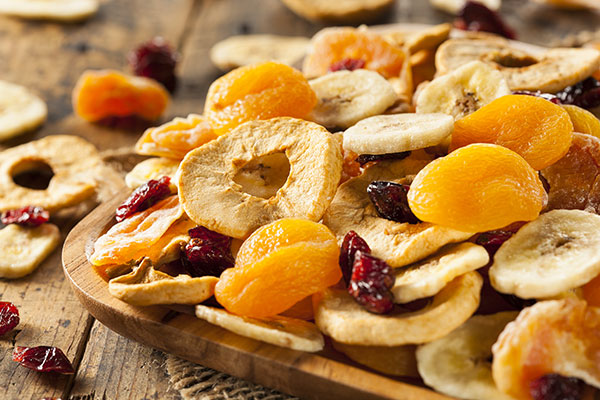Does dried fruit contain too much sugar? As a Registered Dietitian Nutritionist (RDN), my immediate question to this question is too much sugar for what? Although drying fruit removes water and concentrates the calories and sugar, it can still be a valuable food for both athletes and non-athletes including people with diabetes.
Dried fruit is packed with fiber, antioxidants and minerals although vitamin C is lost during the drying method.
People with pre diabetes and diabetes often count and limit carbohydrates which includes sugar from natural sources or added sugar. It doesn’t matter whether the sugar comes from fresh fruit, dried fruit or jam, whole grains, beans, milk or dessert. Often, the nutritional differences are overlooked when blood sugar control is the goal. Many diabetics choose to avoid fruit which is unfortunate since most fresh fruit contains significant amounts of fiber and antioxidants, vitamin A, C and the mineral potassium among other nutrients depending upon the specific fruit.
By Gerri French, MS, RD, CDE
One solution to reduce the spike in blood sugar is simple exercise after eating fruit, even a gentle walk. More exercise usually is more effective, however there can be a temporary spike in sugar with exercise especially competitive exercise that induces adrenalin and a stress response.
Dried fruit is packed with fiber, antioxidants and minerals although the fragile water soluble vitamin C is lost during the drying method. Dried dates and figs both contain potassium and magnesium which are important nutrients for athletes; whole forms of the dried fruit contains more nutrition than processed sources such a fig cookies.
Potassium plays an important role in electrolyte and fluid regulation, nerve function, muscle control, and blood pressure. Magnesium is involved in numerous biologic processes that affect muscle function including oxygen uptake, energy production and electrolyte balance. Regarding the high calorie and sugar content, an active person will enjoy its quick easily digestible energy and convert any excess to glycogen.
Sugar seems to be demonized these days by many authors and health care practitioners. The main reason is because of sugar’s contribution to our obesity epidemic primarily from the empty and extra calories found especially in liquid sugar such as soft drinks, sweetened tea and fruit juice along with candy, sweetened yogurts, ice cream, frozen yogurt and pastries. Sugar and sedentary lifestyle is a dangerous combination.
In the new Nutrition Facts Label there is discussion amongst healthcare teams to make a distinction between natural and added sugars as well as include a recommended percentage of sugar. Part of the reason for this is that sugar increases general inflammation in the body by triggering the release of inflammatory messengers called cytokines. This can contribute to pain and arthritis as well as many modern day diseases such as diabetes, cancer, heart disease and inflammatory bowel conditions. One benefit of natural sources of sugar such as dried fruit is their antioxidant content which reduces oxidation and inflammation. Nature knows best.
If you’re concerned about calories from sugar, mixing dried fruit with various nuts will dilute the sugar and add healthy plant fats and a bit of protein. Consider making your own energy bar with dates and figs, nuts or nut butters (cashews, walnuts, almonds, pistachios), cocoa powder and coconut. Adding dried fruit to green salads and vegetables is another way to minimize the calories and enjoy their sweet taste and texture. A very popular appetizer at a local Santa Barbara restaurant is roasted brussel sprouts with dates.
The following is a recipe from Diabetes Living that is quick and tasty: Date and balsamic recipe
Enjoy!
More Sansum Nutritional Information for Athletes


